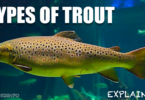The ocean’s depths hide a treasure trove of mysterious and captivating creatures, many of which remain hidden from our sight. Among these intriguing denizens of the deep lies the angel shark, an unusual and fascinating species that occupies a unique role in the marine ecosystem. In this article, let’s dive into the world of the angel shark, exploring where it likes to live, what it likes to eat, and how big it can get, shedding light on the extraordinary life of this special underwater predator.
What is an Angel Shark?
Angel sharks, scientifically known as Squatina spp., belong to the Squatinidae family. They are often called “flat sharks” due to their flattened bodies, which set them apart from the more familiar shark species. These sharks have wide, flat bodies that look more like rays than traditional sharks and have pectoral fins that resemble wings. These unique physical features allow angel sharks to blend seamlessly into their surroundings, where they patiently wait for an opportunity to surprise their prey.
What Habitat Do Angel Sharks Prefer?
Angel sharks live in the tropical and temperate waters of the Indian Ocean, the Atlantic Ocean, and the Mediterranean Sea. They are versatile and can thrive in various environments within these regions.
One key aspect of their habitat is their preference for soft, sandy, or muddy seabed. These types of environments offer the perfect conditions for angel sharks to carry out their unique hunting and survival strategies. They often position themselves partially buried in the sand; a tactic that helps them blend in while staying ready to pounce on their prey.
What is the Dietary Habitat of an Angel Shark?
The dietary habitat of Angel sharks varies because they are opportunistic predators which include a variety of marine creatures. Their eating habits align with their stealthy hunting style, where they lie in wait for unsuspecting prey to swim by before striking with incredible speed and precision. Some of their favorite foods include:
Fish: Angel sharks primarily dine on small to medium-sized fish like flatfish, herring, and mackerel. Their flattened bodies and sharp teeth make them well-suited for capturing and devouring fish that venture too close.
Crustaceans: Besides fish, angel sharks also enjoy a meal of crustaceans like crabs and lobsters.
Squid and Octopus: Angel sharks are known to feast on cephalopods, which include squid and octopus.
Invertebrates: From time to time, they might snack on various invertebrates such as worms and smaller mollusks, showcasing their adaptability.
Interestingly, angel sharks adjust their diet depending on what’s available in their habitat. This flexibility helps them survive in different ecosystems while maintaining a balanced diet.
What is the Average Size of an Angel Shark?
The size of angel sharks can be influenced by environmental factors, such as the availability of food and the quality of their habitat. In areas with plenty of resources, angel sharks may grow faster and attain larger sizes. On average, they measure between 1 to 1.5 meters in length, however, some individuals can grow impressively large, reaching up to 2.4 meters.
There have even been reports of exceptionally massive angel sharks exceeding 3 meters in length and weighing around 77 pounds. Notably, angel sharks display sexual dimorphism, where females tend to be larger than males
Conclusion
The angel shark, with its intriguing habitat choices, diverse diet, and varying sizes among species, stands as an extraordinary inhabitant of the ocean. Its unique appearance, fascinating hunting methods, and specific habitat preferences showcase the incredible diversity and adaptability of marine life. Nevertheless, it’s disheartening that many angel shark species face threats due to habitat degradation, accidental capture in fishing gear, and overfishing. Therefore, conservation efforts must be implemented to make sure that these stunning creatures will live a healthy and long life under the waves.







